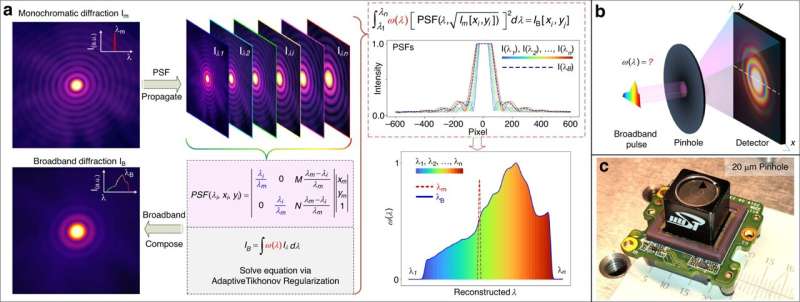
The proposed ultra-simplified diffraction-based spectrometer. Credit: Light: Science & Applications (2024). DOI: 10.1038/s41377-023-01355-4
Spectrometers are crucial scientific instruments in various research fields and have consistently served as indispensable tools for foundational research. However, the unwieldy size of conventional spectrometers poses challenges for cost-effective and compact mobile platforms.
In recent years, miniaturizing spectrometers based on spectral spatiotemporal encoding and numerical computation techniques have gained widespread attention. Nevertheless, complex disperser designs along with advanced material and precision manufacturing technologies primarily underpin existing miniaturized designs. Moreover, intricate calibration issues related to spectral encoding further impede the generalization of simplicity and miniaturization.
In a recent breakthrough, Prof. Shiyuan Liu and his group at Huazhong University of Science and Technology have incorporated the fundamental optical principle of “coherent mode decomposition of broadband diffraction” into their exploration of spectral measurement techniques. Their work has led to the development of an exceptionally streamlined, diffraction-based computational spectrometer.
The research findings, titled “Ultra-simplified diffraction-based computational spectrometer,” have been published in Light: Science & Applications and earned recognition as the cover paper.
“We present a novel and straightforward spectrometer design based on one-to-broadband diffraction mapping for spectral encoding. Our innovative approach incorporates an arbitrarily shaped pinhole as a diffraction-based partial-disperser, positioned in front of the detector. This eliminates the need for intricate pre-encoding designs, making the spectrometer ultra-simplified and highly cost-effective, with a core disperser device priced at nearly one dollar,” the scientists say.
“With just a single capture of the broadband diffraction image, we can accurately determine the spectrum of the incident light’s spectrum. This achievement is made possible through coherent mode decomposition of the captured broadband image. Notably, we have introduced an innovative mapping method based on spectrum-based point spread function derived from a single capture of a monochromatic diffraction image. This mapping enables the generation of a complete spectral response function in spectral spatiotemporal encoding, eliminating the need for pre-encoding design, intricate high-precision fabrication or calibration of the full spectral response function,” they add.
“Our developed spectrometer has demonstrated a reconstructed spectral peak location accuracy better than 1 nm over a bandwidth of 200 nm and a spectral peak resolution of 3 nm, within a compact footprint under half an inch. This represents the first demonstration of a spectrometer design that integrates an ultra-simplified and arbitrarily shaped diffraction structure,” they explain.
“Our design enables single-shot spectrum measurements across a wide wavelength range, from ultraviolet to infrared, with miniaturized lab-on-chip integration. This advancement is crucial for portable applications, offering high robustness, low cost, and long-term stability.”
More information:
Chuangchuang Chen et al, Ultra-simplified diffraction-based computational spectrometer, Light: Science & Applications (2024). DOI: 10.1038/s41377-023-01355-4
Citation:
Revolutionizing spectrometry with ultra-simplicity: Disrupting conventional designs through novel diffraction computing (2024, April 1)
retrieved 2 April 2024
from https://phys.org/news/2024-04-revolutionizing-spectrometry-ultra-simplicity-disrupting.html
This document is subject to copyright. Apart from any fair dealing for the purpose of private study or research, no
part may be reproduced without the written permission. The content is provided for information purposes only.
>>> Read full article>>>
Copyright for syndicated content belongs to the linked Source : Phys.org – https://phys.org/news/2024-04-revolutionizing-spectrometry-ultra-simplicity-disrupting.html
